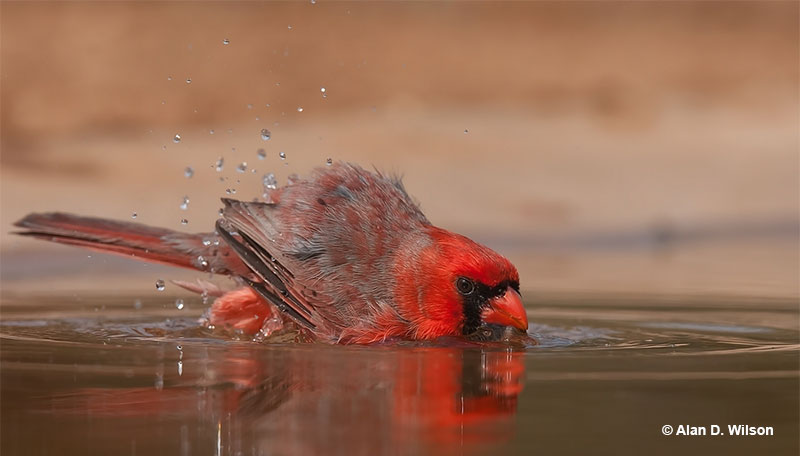
North Carolina is a mid-sized, southeastern state with 53,819 square miles of pine forests, farms, swamps, marshes, and other habitats. Nearly 10,700,00 people live in The Tarheel State. The people of North Carolina have the good fortune of sharing space with lots of beautiful birds!
More than 470 bird species have been found in North Carolina! One of the most common and striking is also the state bird; the Northern Cardinal (Cardinalis cardinalis). This unmistakable red, crested songbird lends a beautiful touch and a cheerful voice to backyards, parks, and other habitats throughout the state.
On this page
State Bird of North Carolina
The Northern Cardinal became the state bird of North Carolina in 1943. Picking an official state bird was long overdue because many other states had already chosen their state birds in the 1930s.
Ironically, North Carolina was actually one of those states. In 1933, following suggestions made by the North Carolina Federation of Women’s Clubs, the state’s General Assembly voted to make the Carolina Chickadee the state bird.
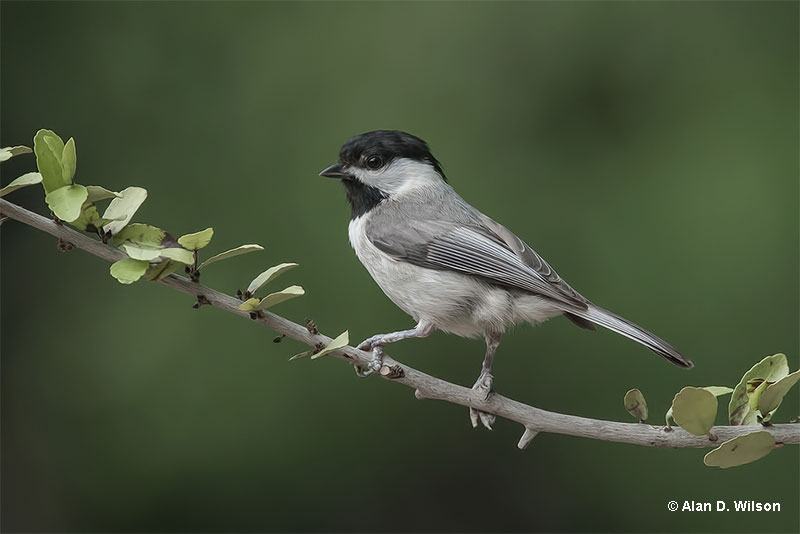
The Carolina Chickadee was almost chosen as North Carolina state bird © Alan D. Wilson
However, that species was also locally known as “The Tomtit.”
Fearing that North Carolina could end up being called, “The Tomtit State”, the lawmakers reversed their decision the following week.
By 1942, the North Carolina Bird Club figured it was about time to pick an official state bird. They put advertisements in newspapers, schools, and other places to encourage folks to pick a bird that would best represent North Carolina.
More than 23,000 people voted, but 26 different species were suggested! These avian candidates included Wild Turkey, Scarlet Tanager, and other favorite bird species. However, since the Northern Cardinal had the most votes (5,000), the General Assembly passed a resolution to name it the official state bird.
Undoubtedly, the Northern Cardinal was chosen because this beautiful, unique bird is a common backyard bird throughout the state.
Fun Facts about Northern Cardinals
- Northern Cardinals have been moving their range north for several decades. Although this bird used to be restricted to the southeastern USA, as the climate has become warmer, it has steadily spread north to southern Canada.
- The red colors on the Northern Cardinal come from their diet. Red and yellow berries provide these birds with carotenoids that have lutein and beta-carotene. The cardinal has a special enzyme that then converts these carotenoids into red plumage. Occasionally, cardinals are born without this enzyme and are yellow.
- The Northern Cardinal is a regular visitor to bird feeders. This species loves sunflower seeds and will nest in backyards that have shrubbery and other dense vegetation.
- Female Northern Cardinals also sing. They usually sing while sitting on their nest and probably do so to communicate with their mate.
- In spring, male Northern Cardinals often fight with their own reflection. This species is very territorial, especially right before the nesting season. At that time of year, males can mistake their reflection in a car mirror or window for another bird, and spend hours trying to drive it away.
- This beautiful species was chosen to be the state bird for seven states.
- The Northern Cardinal was named after the “Cardinals” of the Roman Catholic church. To reflect their high status, these clergy members wear bright red cloaks.
- When agitated or alert, the Northern Cardinal extends the feathers on its head and raises its crest.
- North Carolina is not the only state that has chosen the Northern Cardinal as its state bird. Six other states have gone down the same path – Ohio, Virginia, Illinois, Indiana, West Virginia, and Kentucky have the same state bird.
Identification
The Northern Cardinal is a good-sized songbird with a prominent crest, strong, and a conical orange-red beak. On average, they are between eight and nine inches long and a wingspan of around a foot.
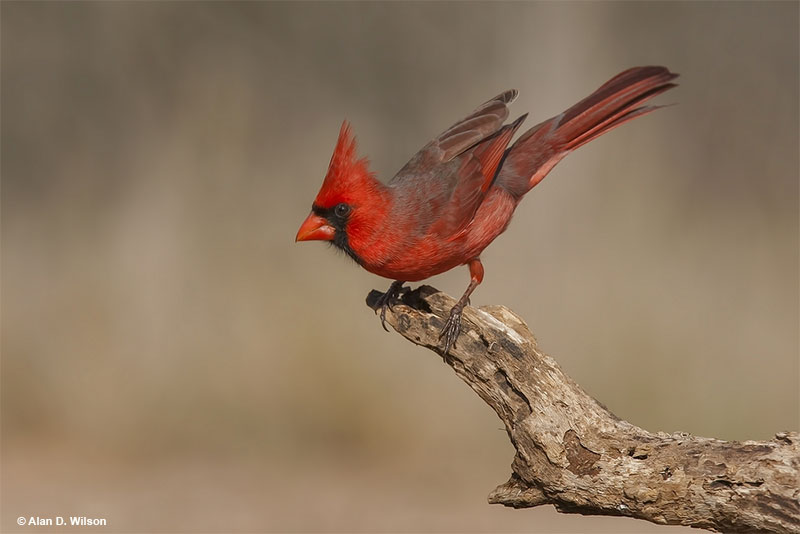
Males and females also have a fairly long, rounded tail but look very different. The male Northern Cardinal is the bird with the familiar, bright red plumage and black face. He usually has duller red colors on his back, wings, and tail.
The Female Northern Cardinal is a pale brown and tan bird with some grayish highlights. She also has some black on her face, and bits of red in her crest, wings, and tail.
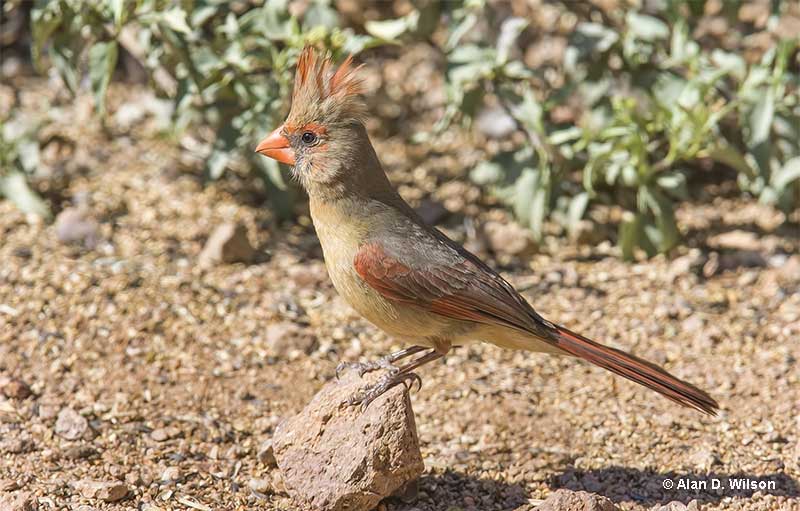
© Alan D. Wilson
Juvenile birds resemble female cardinals but are a duller, gray-brown, and have duller beaks. However, they still have the same general shape and are easily recognized by their crest and strong beak.
In flight, Northern Cardinals make a few quick flaps and then hold their rounded wings flat against their body. This makes the bird look as if it is slightly bouncing up and down as it moves through the air.
What do Northern Cardinals eat?
The Northern Cardinal eats many insects and seeds. It eats beetles, larvae, crickets, and most other bugs it manages to find. This species forages for them by hopping on the ground and picking up insects with its beak. It also moves through bushes and short trees to pick bugs from the vegetation.
In later summer, they start to eat more seeds. By fall and winter, berries and seeds make up the majority of their diet.
Northern Cardinals forage for berries by picking the fruits with their beaks while they are perched. They find seeds on the ground but can also pick some while they are perched.
The Northern Cardinal is also a common visitor to bird feeders. It feeds on seeds, may prefer sunflower seeds, and is usually more frequent at feeders early in the morning and later in the afternoon.
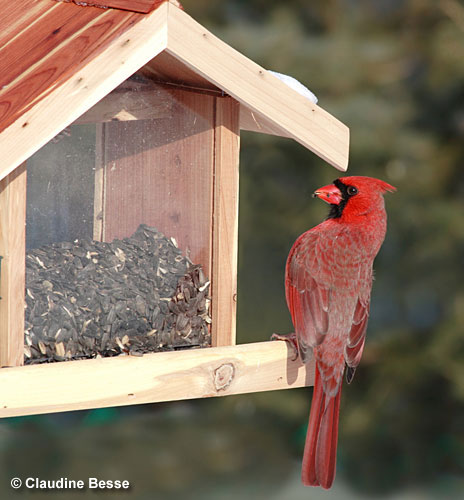
Call
Northern Cardinals make sharp, loud chip notes throughout the year. Becoming familiar with this call is a good way to know when a Northern Cardinal is nearby or hiding in a dense bush.
This species also has a familiar, cheerful, whistled song. Although they can sing at any time of the year, most Northern Cardinals sing in spring and summer.
There are variations of its song but it often sounds like, “What cheer..what cheer..what cheer..chew chew chew chew chew chew”.
Male Northern Cardinals can often be seen singing this song from a tree, top of a shed, or other elevated perch. Females sing too but they don’t sing as often as the male, and usually sing while sitting on their nest.
Behavior
Northern Cardinals are usually seen in pairs. In spring and summer, this species forms pairs that defend a territory from other cardinals. Later on in the year, they can still defend a territory but can also form small flocks with other Northern Cardinals.
Such groups of wintering cardinals can gather at feeders and trees laden with berries. When they aren’t feeding in a bush or tree, Northern Cardinals spend much of their time picking up seeds from the ground, or foraging and resting in low bushes.
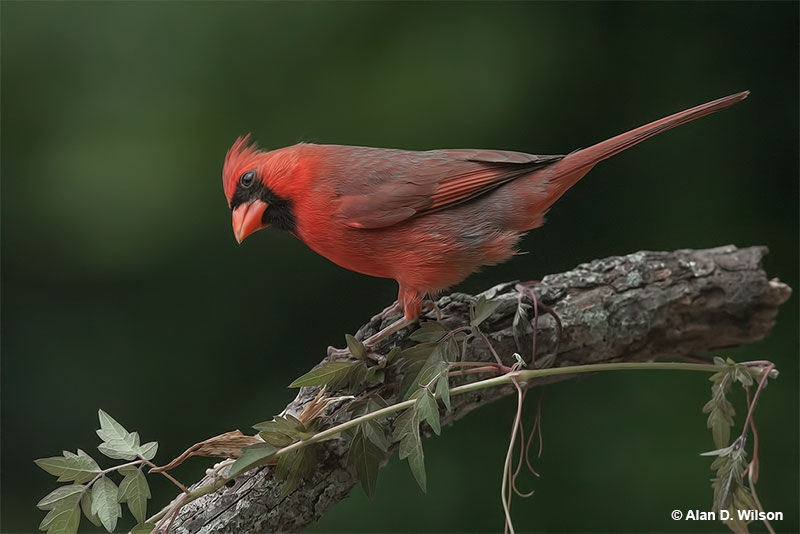
They prefer semi-open areas with plenty of low, dense bushes that provide food and good hiding places from predators. This species has to watch out for Cooper’s Hawks and other predators and isn’t shy about giving alarm calls when it spots a cat or other threat.
Unless a Northern Cardinal is singing, it is not usually seen perched high in a tree, and rarely flies over large areas of open ground. Instead, this familiar bird prefers to live near and in low, dense cover.
North Carolina State Bird – Frequently Asked Questions
How many bird species are in North Carolina?
There are 479 bird species in North Carolina. This is the number of bird species that have been accepted for the North Carolina bird list.
What is the rarest bird in North Carolina?
The rarest bird in North Carolina is the Black-capped Petrel. This endangered species is occasionally seen in Gulf Stream waters of North Carolina. The Red-cockaded Woodpecker is another rare, and Near Threatened species that live in North Carolina.
What birds are North Carolina known for?
North Carolina is known for many birds, but perhaps the most important one is the Northern Cardinal, which also happens to be the state bird. This state is also known for common southern birds like Tufted Titmouses and Carolina Chickadees.
Keep reading: Most common birds of North Carolina & Hawks in North Carolina

